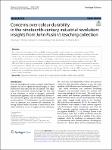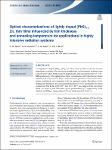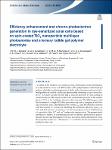Search
Author
- Adam, A. G. (1)
- Balusson, Clara (1)
- Bandara, T. M. W. J. (1)
- Beeby, Andrew (1)
- next >
Subject
- DSC (2)
- CdS (6 nm) (1)
- DTA (1)
- macro-XRF (1)
- next >
Date issued
- 2023 (7)
Has File(s)
- true (7)
Search Results
Fusion-bonded and low-diluted overlay welded coatings are frequently very thick (>1mm). High-speed laser cladding is a novel process capable of producing thin fusion-bonded and low-diluted coatings with high coverage rates and low heat input. In this study, for the first time, high-speed laser cladding was used to fabricate relatively thin Ni-based coatings reinforced with chromium carbides onto low-alloy structural and quenched and tempered steels. Obtained coatings were characterized with X-ray diffraction (XRD), optical (OM), and scanning electron microscopy (SEM), as well as electron backscatter diffraction (EBSD). Mechanical and wear properties were tested with Vickers microhardness measurements and three-body dry-sand rubber wheel abrasion tests (RWAT). |
The numerous new pigments that gradually became available to artists during the nineteenth-century Colour Revolution were received with contrasting attitudes. The initial enthusiasm for new chromatic possibilities was soon nuanced by concerns about the stability and performance of industrial materials. This study focuses on the work of John Ruskin, the famous art critic of Victorian England, whose artistic production was as impressive as his penmanship. Archival research into nineteenth-century literature is combined with material analyses with macro-XRF, XRD and FORS on a group of watercolours by Ruskin preserved at the Ashmolean Museum to determine his attitude towards pigment stability. |
Electrical transport properties of YBa2Cu3Oy implanted by CdS nanoparticles nanoparticle size effect Cadmium sulfide nanoparticles size effects on the superconducting properties of YBa2Cu3Oy compound were investigated in details. Solid-state reaction method was used for the synthesis of samples with additional amounts of CdS nanoparticles with sizes 6 nm and 12 nm and an additional amount x = 0.1 wt%. Synthesis of cadmium nanoparticles was done by using aqueous methods and they were characterized by using transmission electron microscopy (TEM), X-ray diffraction (XRD). Optical absorption measurement of the as-synthesized nanoparticles was carried out, and the specific surface areas of the sample were analyzed using a surface area and porosity analyzer. Electrical resistivity and transport critical current densities were measured by using the four-probe technique. The measurements r... |
Zr-based bulk metallic glasses (BMGs) are characterized by excellent glass-forming ability, combined with superior mechanical properties. However, oxygen impurities degrade both these aspects as oxides serve as heterogeneous nucleation sites during solidification. Rare-earth elements (REEs) are known to be good oxygen scavengers, binding oxygen to less harmful forms. The most stable rare-earth oxide (REO) is M2O3, which occurs in three polymorphic forms, depending on the radius of metal cation: cubic, hexagonal, and monoclinic. Here, we show the effect of Sc, Y, Lu, Nd, and Gd additions in relation to the oxygen content on the glass-forming ability of the Zr52.5Cu17.9Ni14.6Al10Ti5 alloy. Microscopic observations (SEM) supported by chemical analysis (EDS, WDS), structure identificati... |
SnxSb20Se80−x bulk glasses were prepared using the well-known melt quenching technique, where x was taken as 7.5 at.%, 9.5 at.%, 11.5 at.% and 13 at.%. X-ray diffraction (XRD) and differential scanning calorimetery (DSC) were used to monitor the crystallinity and transition temperatures, respectively. XRD examinations showed that the 7.5 at.% and 9.5 at.% compositions were purely amorphous, while the other two compositions exhibited a crystalline structure. DSC thermograms demonstrated that 7.5 at.% and 9.5 at.% alloys had a single crystallization peak, whereas for the 11.5 at.% and 13 at.% alloys, two exothermic peaks and three peaks appeared. |
The lightly Zn-doped (PbS)1−x (Zn)x thin films were synthesized by the thermal deposition technique. The structure, morphology, and elemental analyses were carried out by XRD, SEM, and EDS, respectively, and characterised by UV–VIS–NIR spectroscopy. The optical absorption, transmission, and reflection have been studied and analysed. The linear and non-linear parameters have been determined, explained, and compared with the reported results. The effects of Zn-doping, film thickness, and annealing temperature on NLO-parameters have been considered. The better 2.78 × 10–10 and 2.93 × 10–10 esu values of the non-linear refractive index n2 and 3rd-order optical polarizability χ(3), respectively, were attained by (PbS)0.97 (Zn)0.03 film of 150 nm thick annealed at 200 °C. |
he effect of the thickness of a multilayer TiO2 photoanode on the performance of a dye-sensitized solar cell (DSC) made with a polyethylene oxide-based gel polymer electrolyte containing ternary iodides and performance enhancer 4-tert-butylpyridine is studied. Multilayer photoanodes consisting of up to seven layers of TiO2 nano-particles (13 nm and 21 nm) are prepared by spin coating of successive layers. XRD results confirm the predominant presence of the anatase phase of TiO2 in the multilayer structure after sintering. The SEM images reveal the formation of a single TiO2 film upon sintering due to merging of individually deposited layers. The photocurrent density (JSC) and the efficiency increase with the number of TiO2 layers exhibiting the maximum efficiency and JSC of 5.5% and... |







